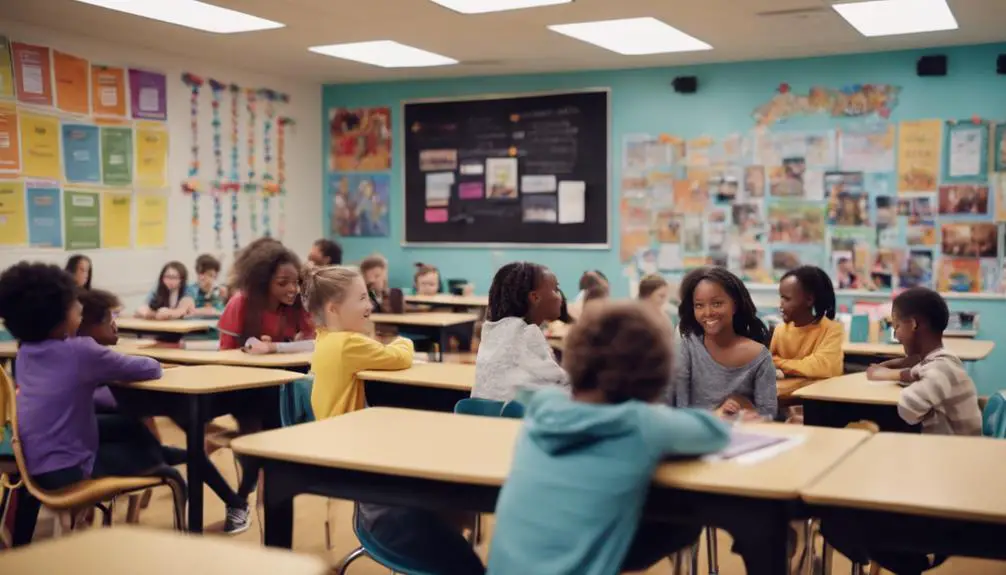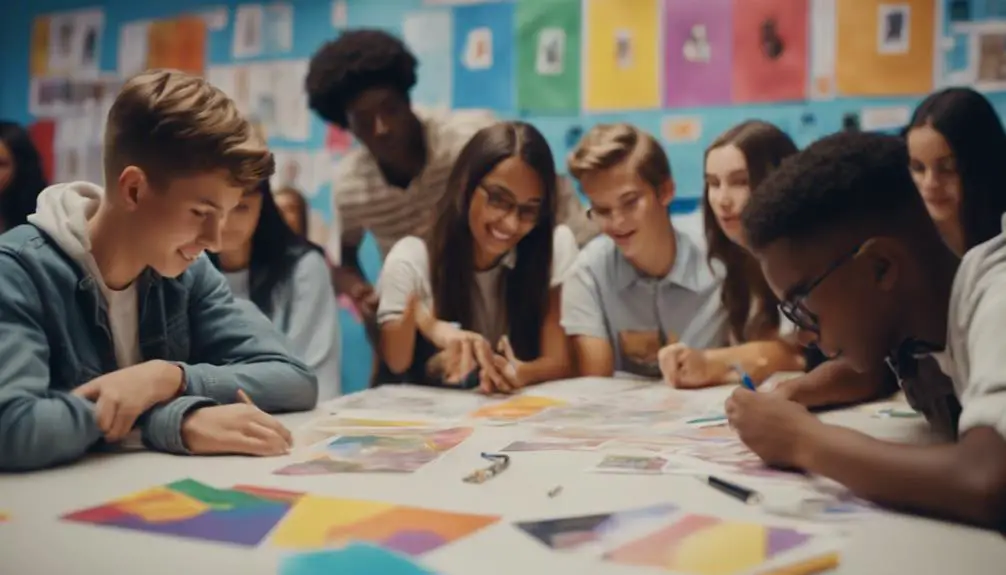Creating a culture of learning in the classroom is like planting seeds in fertile soil; it needs attention, care, and nurturing. Teachers aim to cultivate an environment where curiosity thrives, and knowledge grows.
But how can we truly instill this growth mindset in students, inspiring them to become lifelong learners?
Let’s look at the practical strategies that go beyond traditional methods, paving the way for an enriching educational journey that extends beyond the classroom walls.
How I Establish A Culture for Learning in My Classroom

In my classroom, I establish clear learning objectives to help my students succeed.
I motivate them to adopt a growth mindset, encouraging them to view challenges as opportunities for personal development.
Creating a safe and interactive learning atmosphere is vital for fostering student engagement and collaboration.
Set clear learning goals
Clearly communicate what you expect students to learn and achieve in your class.
Setting clear learning goals in my classroom involves clearly stating specific objectives to guide students toward academic success. When I articulate learning outcomes and classroom expectations, I aim to boost student engagement and foster skill development. By effectively communicating these goals, students grasp the purpose of their studies and are motivated to strive for academic excellence.
Establishing clear expectations not only provides a roadmap for students but also gives them a sense of direction and purpose in their learning journey. Emphasizing the importance of these goals creates a supportive environment where students are inspired to excel and reach their full potential, ultimately contributing to their overall growth and development.
Foster a growth mindset
Encourage students to view challenges as opportunities for growth and improvement.
In my classroom, I encourage students to see challenges as opportunities to grow and improve. Developing a growth mindset is crucial, as it helps students believe in their ability to progress through effort.
By emphasizing learning opportunities in challenges, students can acquire new skills and knowledge. It’s important to shift the focus from grades to personal growth and celebrate students’ positive development.
Create a safe learning environment
Make sure students feel comfortable asking questions and taking risks in their learning.
In my classroom, I focus on creating a safe and inclusive learning environment where students feel comfortable asking questions and taking educational risks. Open communication is key to building trust and fostering a questioning culture that encourages curiosity and engagement.
I support students in taking risks by instilling confidence and helping them see challenges as opportunities for growth. Embracing mistakes as part of the learning process enhances students’ learning confidence and promotes a growth mindset.
Ultimately, my goal is to cultivate a supportive culture where students feel valued, motivated, and empowered to excel academically.
Provide engaging and interactive lessons
Use a variety of teaching strategies to keep students actively involved in their learning.
In my classroom, I use a variety of teaching methods to actively engage students in their learning. Here are some ways I ensure students participate and get involved in my lessons:
- Hands-on activities: I include practical tasks and experiments to make lessons more interesting.
- Discussions: I encourage dialogue and debate among students to promote interactive learning.
- Technology integration: I use educational apps and tools to enhance engagement and make lessons more interactive.
- Group activities: I organize collaborative projects and team-based tasks to encourage teamwork and peer learning.
Encourage collaboration
Foster teamwork and group projects to encourage peer learning and support.
By promoting teamwork and incorporating group projects, I create an environment that fosters peer learning and support in my classroom. Collaboration allows students to experience the dynamics of working together, engage in peer interactions, reap the benefits of group projects, learn from their classmates, and hone their teamwork skills.
| Benefits of Teamwork | Peer Collaboration | Advantages of Group Projects |
|---|---|---|
| Improves communication | Encourages creativity | Provides diverse perspectives |
| Builds trust | Strengthens relationships | Enhances problem-solving skills |
| Fosters leadership | Facilitates learning | Encourages active participation |
Offer feedback
Provide constructive feedback to help students understand their strengths and areas for improvement.
Creating a culture of learning in my classroom involves giving helpful feedback that allows students to see their strengths and areas for growth. Feedback is a valuable tool for progress and improvement. Here are some ways I integrate feedback into my teaching approach:
- Peer feedback: Encouraging students to share feedback with their peers promotes a supportive learning environment.
- Setting goals: Establishing clear learning objectives helps students understand their aims.
- Assessing skills: Regular evaluations help identify areas where students excel and where they can improve.
- Tracking progress: Monitoring and sharing students’ progress with them helps keep them motivated.
Use technology
Incorporate educational technology to enhance learning opportunities and engage students.
In my classroom, I use educational technology to enhance learning and engage my students effectively. Technology is essential in today’s education, providing interactive tools and digital resources that cater to different learning styles.
Virtual platforms allow students to access materials at their convenience, promoting flexibility and independent learning. Integrating technology not only makes lessons more engaging and enjoyable but also helps students develop crucial digital literacy skills for the future.
Embracing Mistakes as Learning Opportunities
In our classroom, we see mistakes as valuable learning opportunities that help students grow and develop. Building resilience is crucial in our approach, as we encourage students to persist through challenges.
Learning from failure is a vital part of the learning journey, teaching students to analyze their mistakes and gain meaningful insights. We believe that growth stems from mistakes; they aren’t obstacles but stepping stones toward progress.
Celebrate diversity
Respect and celebrate the individual differences and unique contributions of each student.
In my classroom, celebrating diversity is about recognizing and appreciating the unique differences and contributions of each student. By creating an environment that values diversity, I establish a culture where individuality isn’t just accepted but embraced.
I actively encourage inclusivity by highlighting the distinct strengths that each student brings to our learning community. Embracing these differences enriches our discussions and widens our perspectives. My goal is to foster empathy, respect, and a sense of belonging among all students.
Promote a love for reading
Encourage students to explore different genres and authors to develop a love for reading.
Embracing the diverse backgrounds and talents of my students sets the stage for fostering a love for reading in my classroom by encouraging the exploration of various genres and authors.
Tips to Cultivate a Love for Reading:
- Reading Adventures: Spark curiosity with captivating stories spanning different genres.
- Genre Exploration: Introduce students to a wide array of literary styles to help them discover their preferences.
- Author Appreciation: Showcase the distinct voices and styles of various writers to ignite admiration and interest.
- Book Club: Cultivate a sense of community through group discussions and shared reading experiences.
- Reading Rewards: Offer incentives for reaching reading milestones to inspire and celebrate students’ literary accomplishments.
Incorporate real-world applications
Connect classroom learning to real-life situations to show its relevance and importance.
Incorporating real-world examples in my teaching approach helps students understand and engage more effectively by showing them the practical relevance of what they learn in the classroom. By connecting theories and concepts to real-life situations, students can see how their studies apply to practical scenarios.
This approach not only highlights the importance of their learning but also boosts their classroom involvement. When students can relate their knowledge to real-world experiences that mirror what they may encounter outside the classroom, they grasp the material more thoroughly.
Encouraging these connections to real life not only deepens their comprehension but also equips them for real-world challenges. Ultimately, creating a learning environment that emphasizes practical applications motivates students to learn and develop.
Use hands-on activities
Provide hands-on experiences to help students apply theoretical knowledge in practical ways.
Implementing hands-on activities in the classroom improves students’ practical application of theoretical knowledge. Through interactive experiments, projects, and real-world simulations, students engage with the material in a more profound way than traditional lectures.
These experiences demonstrate the relevance of their learning and how it can be utilized in various contexts. By actively participating in these activities, students gain a deeper understanding of the subject matter and acquire valuable skills applicable beyond the classroom.
This active learning approach not only enhances understanding but also equips students to tackle real-world challenges effectively.
Encourage self-reflection
Teach students to reflect on their learning process and set goals for improvement.
Encouraging students to engage in self-reflection helps create a culture of continuous improvement in my classroom.
By using self-assessment strategies, goal-setting techniques, reflection exercises, progress monitoring methods, and improvement plans, I guide students to take charge of their learning journey. Through structured reflection activities, students pause to analyze their strengths and areas for growth, setting specific goals to enhance their understanding.
I employ progress monitoring methods to track their development and offer targeted support where necessary. This approach empowers students to be proactive in their learning, nurturing a sense of responsibility and dedication to their educational growth.
Model lifelong learning
Show students that learning is a continuous process by sharing your own learning experiences and challenges.
In my classroom, I demonstrate the importance of lifelong learning by openly sharing my own ongoing learning experiences and challenges with students. Through showcasing my personal growth, continuous improvement, and learning journeys, I aim to cultivate a culture of lifelong education among my students.
This approach emphasizes that learning is a continual process beyond graduation. By sharing both my struggles and successes, I create a relatable atmosphere that encourages students to embrace challenges as opportunities for growth. Not only does this practice enrich my teaching, but it also strengthens the connection with student experiences.
Create a positive classroom culture
Build a sense of community and mutual respect among students to encourage a positive learning environment.
Creating a positive classroom culture in my class involves nurturing a strong sense of community and mutual respect among students. I focus on building relationships by promoting open communication and collaboration. Group activities and discussions are organized to enhance bonds and foster a sense of belonging.
Encouraging active participation and valuing each student’s perspective establishes trust within the class. By cultivating respect for diverse ideas and viewpoints, I create an inclusive environment where students feel valued and supported. These efforts aim to cultivate a space where learning thrives, and students are inspired to actively engage in their educational journey.
Promote a growth mindset
Encourage students to embrace challenges, persevere through setbacks, and believe in their ability to learn and improve.
In my classroom, I encourage students to approach challenges with a positive outlook, persist through setbacks, and have faith in their ability to learn and grow. Adopting a growth mindset is vital for students to build resilience and stay motivated in their educational journey.
Here are some practical ways I nurture this mindset:
- Seeing challenges as opportunities for growth: I help students view challenges as chances to improve and develop new skills.
- Teaching strategies to overcome obstacles: I equip students with tools to navigate hurdles and setbacks effectively.
- Emphasizing self-belief in learning: I stress the importance of believing in oneself and one’s capacity to learn and improve.
- Creating a supportive environment: I foster a culture where perseverance in learning is valued and encouraged.
Conclusion
Creating a culture of learning in my classroom involves sparking curiosity and nurturing it with knowledge. Together, my students and I care for the garden of education, witnessing its growth and understanding.
By planting the seeds of learning, we establish a fertile ground for success to grow. Let’s continue to foster a rich environment of knowledge where every student can thrive.















